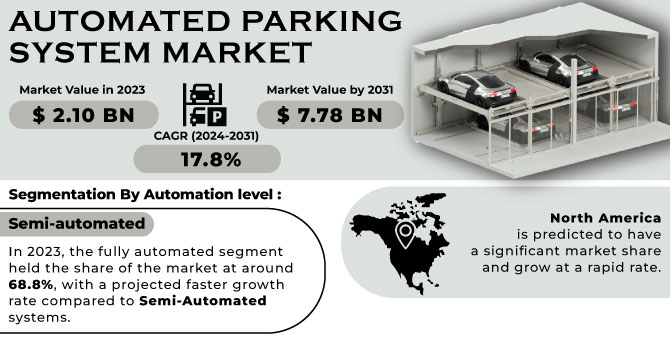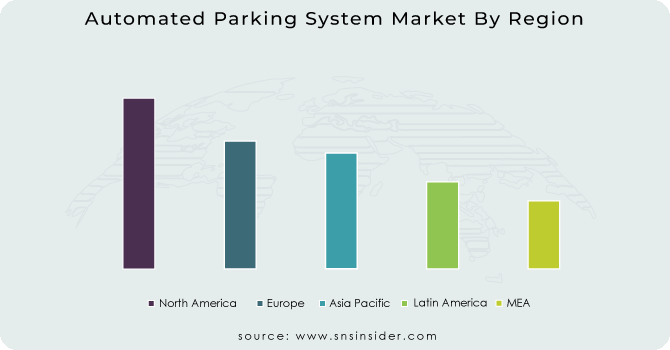Automated Parking System Market Size

Get More Information on Automated Parking System Market - Request Sample Report
The Automated Parking System Market size was valued at USD 2.10 billion in 2023 and is expected to reach USD 7.78 billion by 2031, and grow at a CAGR of 17.8% over the forecast period 2024-2031.
Automated parking systems use vertical stacking to save space and eliminate the need for human drivers, making them ideal for crowded cities with limited parking. This not only saves space but also reduces construction costs by eliminating elevators, ramps, and other unnecessary infrastructure. The market for these systems is growing due to a combination of factors including smart city initiatives, a rise in smart buildings and luxury developments, and real estate developers' preference for automation. Rapid urbanization is also a major driver as it creates a growing demand for parking solutions in space-constrained areas. Technological advancements in areas like sensors, robotics, and AI are making automated parking systems more efficient and reliable. Thus, the integration of various smart technologies like IoT sensors and guidance systems further enhances their performance, making them even more attractive to developers and users.
| Report Attributes | Details |
|---|---|
| Market Segmentation | • by Automation level (Semi-automated, Fully automated) • by System type (Hardware, Software) • by End-user (Commercial, Residential, Mixed-use) • by Design Model (Hydraulic, Electro-mechanical) • by Platform type (Palleted, Non-palleted) • by Parking level (Less than level 5, Level 5- level 10, More than level 15) |
| Regional Analysis | North America (US, Canada, Mexico), Europe (Eastern Europe [Poland, Romania, Hungary, Turkey, Rest of Eastern Europe] Western Europe] Germany, France, UK, Italy, Spain, Netherlands, Switzerland, Austria, Rest of Western Europe]), Asia Pacific (China, India, Japan, South Korea, Vietnam, Singapore, Australia, Rest of Asia Pacific), Middle East & Africa (Middle East [UAE, Egypt, Saudi Arabia, Qatar, Rest of Middle East], Africa [Nigeria, South Africa, Rest of Africa], Latin America (Brazil, Argentina, Colombia, Rest of Latin America) |
| Company Profiles | Wohr, Boomerang Systems, Klaus Multi Parking, FATA Automation, AJ Automated Parking System, CityLift, Mitsubishi Electric Corporation, Westfalia, Expert Parking, TAPS, Robotic Parking Systems Inc., and Unitronics |
MARKET DYNAMICS:
KEY DRIVERS:
-
Urbanization Drives Demand for Efficient Parking Solutions
Urbanization, the large-scale movement of people from rural to urban areas, is causing a significant rise in urban populations. As cities expands and replace rural landscapes, the demand for efficient parking solutions grows alongside the construction of new residential and commercial buildings. This increasing population density necessitates innovative parking systems to accommodate the rush of vehicles and ensure a smooth flow of traffic within urban centres.
-
Rising popularity of high-rise buildings, luxury projects, and real estate developers' preference for automated solutions is fueling market growth.
RESTRAINTS:
-
Adapting existing parking facilities for automated systems might require significant modifications.
-
High upfront costs for technology, robotics, and infrastructure modifications can limit adoption.
OPPORTUNITIES:
-
Growing urbanization and limited land space in cities present a significant opportunity for space-saving automated parking systems.
-
Advancements in sensor technology, robotics, and AI can further improve the efficiency, reliability, and user experience of automated parking systems.
CHALLENGES:
-
The high cost of initial installation, due to advanced technology features, is a hurdle for wider adoption of automated parking systems.
The high upfront cost is hindering the widespread adoption of automated parking systems. This stems from the use of advanced technologies like robotics and sensors, which significantly inflate the overall price of the system. Though, these features enhance efficiency and functionality, they also create a financial barrier for potential users such as property developers and parking facility operators.
KEY MARKET SEGMENTS:
By Component
Hardware is the dominating sub-segment in the Automated Parking System Market by component holding around 80-85% of market share. Hardware forms the core functionality of automated parking systems. It includes mechanical structures, sensors, robotics, and control systems. These components are essential for the physical movement and management of vehicles within the system. Software plays a crucial role, but its effectiveness relies heavily on the underlying hardware infrastructure.
By Structure Type
Tower System is the dominating sub-segment in the Automated Parking System Market by structure type holding around 25-30% of market share. Tower systems offer a space-saving, high-capacity design ideal for urban environments with limited space. Vehicles are stacked vertically in a tower-like structure, maximizing parking capacity within a small footprint. This makes them a popular choice for commercial and residential buildings with high parking demand.
By Platform Type
Palleted Systems is the dominating sub-segment in the Automated Parking System Market by platform. Palleted systems utilize a platform or "pallet" that cradles the vehicle. This platform moves on rails or tracks, offering a simpler and more cost-effective design compared to non-palleted systems. Their relative ease of installation and lower initial cost make them a popular choice for various applications.
By Automation Level
Fully Automated is the dominating sub-segment in the Automated Parking System Market by automation level. Fully automated systems offer the highest level of convenience and efficiency. They eliminate the need for driver interaction, streamlining the parking process. This makes them ideal for congested urban areas and high-traffic locations where speed and ease of use are crucial.
By End Use
Commercial is the dominating sub-segment in the Automated Parking System Market by end use. Commercial applications, such as office buildings, shopping malls, and airports, require large parking capacities to accommodate high volumes of vehicles. Automated parking systems offer a space-saving and efficient solution for these needs. Additionally, commercial developers are often more receptive to adopting new technologies like automated parking systems compared to residential settings.
REGIONAL ANALYSES
The Europe is the dominating region in the Automated Parking System Market holding around 34.2% of market share, fueled by a strong presence of leading solution providers, advanced technological infrastructure, and government initiatives for smart cities.
North America is the second highest region in this market due to high demand for parking solutions in dense areas, a focus on innovation, and major automotive manufacturers fostering synergy with the parking industry.
The Asia Pacific is experiencing the fastest growth in this market with a projected growth rate of 18.7%. This is driven by rapid urbanization, economic growth leading to increased car ownership, and a lack of parking space. Government investments in infrastructure and smart city projects further propel the market's growth in this region.

Get Customized Report as per your Business Requirement - Request For Customized Report
KEY PLAYERS
The major key players are Wohr (Germany), Boomerang Systems, Klaus Multi Parking (Germany), FATA Automation, AJ Automated Parking System, CityLift (US), Mitsubishi Electric Corporation, Westfalia (Germany), ParkPlus, AutoStow Solutions, SkyPark Engineering, Expert Parking, TAPS, Robotic Parking Systems Inc. (US), Unitronics and other key players.
FATA Automation-Company Financial Analysis

RECENT DEVELOPMENT
-
In Nov. 2023: Utron's automated parking system is now operational in Boston's Financial District. This innovative system features 6 floors, 256 conveyors, and 235 parking spaces, making efficient use of space. It even includes 24 dedicated charging stations for electric vehicles.
-
In May 2023: Shijiazhuang Shopping Centre in China unveiled a high-tech parking solution. Their new underground system automates parking for 156 vehicles, with the potential to expand and meet future demand.
-
In Jan. 2023: Germany is expanding its automated parking system beyond Stuttgart Airport. Partnering with Bosch, APCOA plans to equip 15 more garages nationwide, prompting infrastructure development to support this technology across the country.
| Report Attributes | Details |
| Market Size in 2023 | US$ 2.10 Bn |
| Market Size by 2031 | US$ 7.78 Bn |
| CAGR | CAGR of 17.8% From 2024 to 2031 |
| Base Year | 2023 |
| Forecast Period | 2024-2031 |
| Historical Data | 2020-2022 |
| Report Scope & Coverage | Market Size, Segments Analysis, Competitive Landscape, Regional Analysis, DROC & SWOT Analysis, Forecast Outlook |
| Key Drivers | • The time spent looking for a parking spot waste contributes to pollution, and can be avoided by using an automated parking system. • The efficiency of an automated parking system improves, allowing more vehicles to be parked in less area. |
| Challenges | • An automated parking system is more efficient but the construction costs are significant at first. • Several companies do not appreciate automated parking systems due to the large costs involved. |

